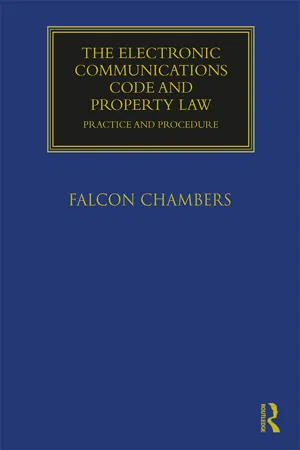
The Electronic Communications Code and Property Law
Practice and Procedure
Falcon Chambers
- 898 pages
- English
- ePUB (mobile friendly)
- Available on iOS & Android
The Electronic Communications Code and Property Law
Practice and Procedure
Falcon Chambers
About This Book
Life now without access to electronic telecommunications would be regarded as highly unsatisfactory by most of the UK population. Such ready access would not have been achieved without methodical and ultimately enforceable means of access to the land on which to install the infrastructure necessary to support the development of an electronic communications network. Successive governments have made such access a priority, regarding it as a principle that no person should unreasonably be denied access to an electronic communications network or electronic communications services. The enactment of the Telecommunications Act 1984 and its revision by the Communications Act in 2003 have played their role in the provision of an extensive electronic infrastructure in the UK, while their reshaping by means of the Digital Economy Act 2017 will continue that process. Throughout that process, a little publicised series of struggles has taken place between telecommunications operators and landowners, as they seek to interpret the Electronic Communications Code by which their rights and obligations have been regulated.
This book describes the problems that accompanied the Old Code (which will continue to regulate existing installations and agreements); and the intended solutions under the New Code. The eminent team of authors explain the background, provisions and operation of the old code and the new one, providing practical and jargon-free guidance throughout. It is sure to become the reference on this topic and is intended as a guide for telecommunications operators, land owners, and of course for their advisers in the legal and surveying professions.
All members of Falcon Chambers, comprising nine Queen's Counsel and 30 junior barristers, specialise in property law and allied topics, including the various incarnations of the Electronic Communications Code. Members of Falcon Chambers, including all the authors of this new work, have for many years lectured and written widely on the code, and have appeared (acting for both operators and landowners) in many of the few reported cases on the subject of the interface between property law and the code, including for example: Geo Networks Ltd v The Bridgewater Canal Co. Ltd (2010); Geo Networks Ltd v The Bridgewater Canal Co. Ltd (2011); Crest Nicholson (Operations) Ltd v Arqiva Services Ltd (2015); Brophy v Vodafone Ltd (2017).
Frequently asked questions
Table of contents
- Cover
- Half Title
- Title Page
- Copyright Page
- Contents
- Preface
- Contributors Falcon Chambers
- Foreword
- Table of Cases
- Table of Statutes
- Table of Statutory Instruments
- Glossary
- Part I Introduction
- Part II Electronic Communications Code 2003 (the Old Code)
- Part III Electronic Communications Code 2017 (the New Code)
- Part IV Matters common to both codes
- Part V Drafting
- Part VI: The New Code – Annotated
- PART VII Appendices
- Index